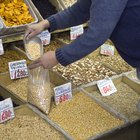Paper, which is made from the pulp of wood from trees, is generally considered a non-renewable resource because trees are being cut down faster than they can grow. Because paper is in such high demand in our society, paper recycling is important. Many types of paper can be ground back down to a pulp and remade into paper to be used again. But there are some kinds of paper that should not be recycled.
Soiled Paper
You should always throw dirty paper away in the trash, and never in the recycling bin. The city of San Francisco's recycling website lists pizza boxes, napkins, tissues, paper towels, paper plates and take-out boxes as common examples of unclean paper that should not be recycled. It's important not to get food in your recyclables because of the way paper is processed; it is mixed with water and turned into a slurry of pulp. If this slurry is contaminated with oil from food, it ruins the entire mixture and it must be dumped in a landfill instead of dried into new paper. Soiled paper also poses a health hazard to the people who work in the recycling plants who try to separate out contaminants. Old tissues, napkins and food can carry dangerous viruses, bacteria and molds.
Shredded Paper
Many people shred confidential papers to protect their privacy. Unfortunately, shredding paper shortens and weakens the length of the paper fiber, which needs to be long and strong in order to be worth recycling. Therefore, according to the Earth911 website, you should not put shredded paper in with your recycling. But the good news is that although you cannot recycle your shredded paper, you can compost it. It is necessary to add substances that are high in carbon and low in nitrogen, such as paper, to compost piles to offset nitrogen-rich decaying food so composting is a great way to reuse shredded paper.
Wax, Plastic or Foil-Coated Paper
Some items that are mainly composed of paper also have a small amount of wax, plastic or foil added to them, rending them not recyclable. Frozen food boxes, juice boxes, dairy milk cartons and soymilk cartons are specific types of these items, according to Earth911. The thin layer of foil lining the inside of soymilk containers, for example, is necessary to maintain its freshness, but is too difficult to separate from the paper during the recycling process. Carefully examine paper cartons that you are unsure of-opening them up to revel the insides if necessary-so that you do not accidentally recycle paper with one of these contaminates on it.
Related Articles

What Items Can't Be Recycled?

Advantages of Paper Bags vs. Plastic ...

Toilet Paper vs. Bath Tissue

What Is Blotting Paper Made Of?

The History of Bamboo Fabric

What Are the Uses of Vermicompost?

Environmental Impact of Disposable ...

Advantages of Vermicompost

Heating Foods in Plastic & BPA

What Happens if You Cook Chicken With ...

Purpose of Moth Balls

Cellophane vs. Polypropylene

What Are the Dangers of Plastic Bags ...

5 Easy Steps to Prep Cardboard for ...

What Are the Benefits of Torula Yeasts?

Types of Biodegradable Products

Plastic Recycling Levels

List of Ways to Conserve Mother Nature

List of Biodegradable, Every Day ...

How to Make Biodegradable Confetti
References
Writer Bio
A freelance writer based in San Francisco, Ann Bartkowski began writing professionally for the New York State Department of Heath in 2006 as a science educator. She holds a Bachelor of Science in biology from Bates College. Bartkowski has published numerous articles for various websites, specializing in nutrition, children, health and the environment.